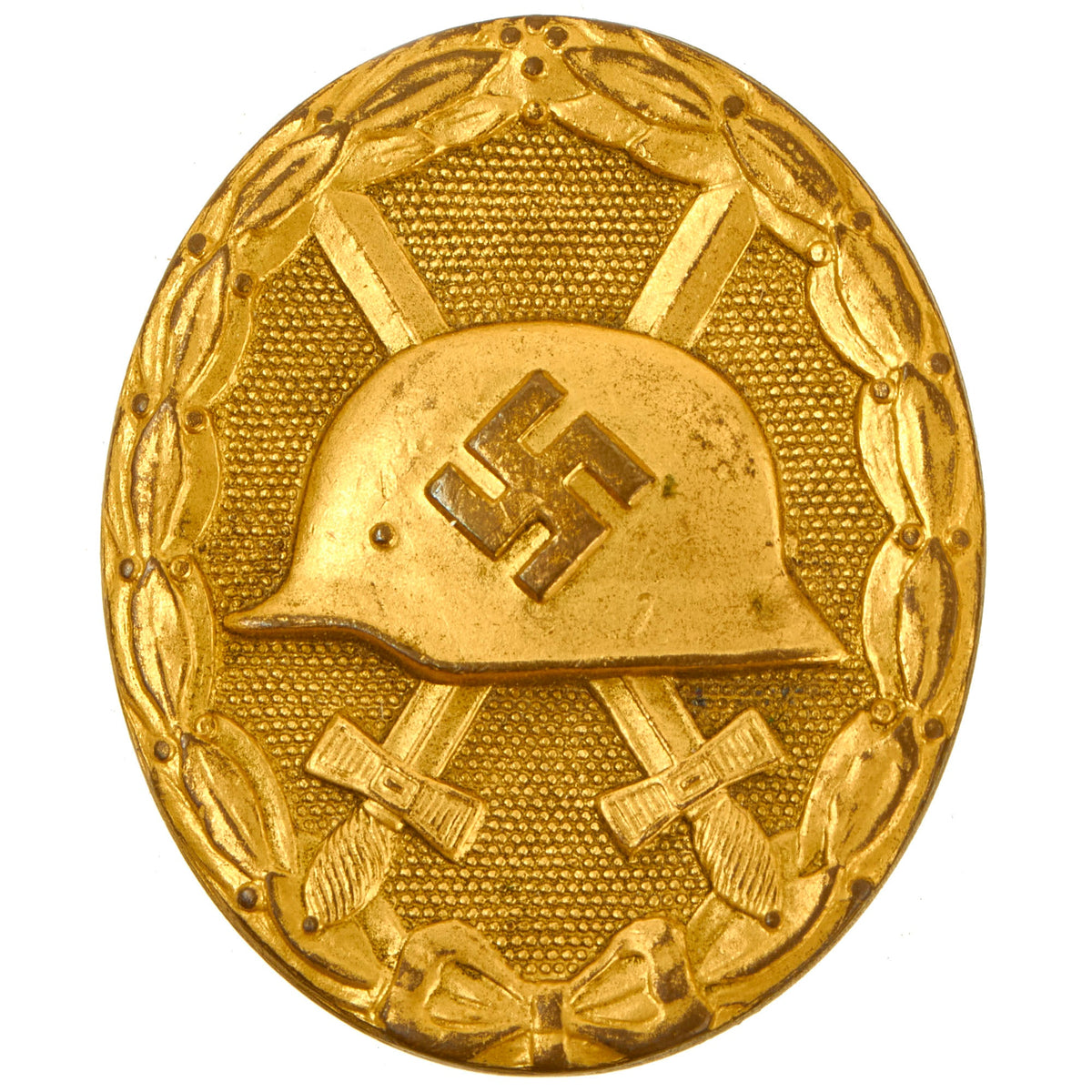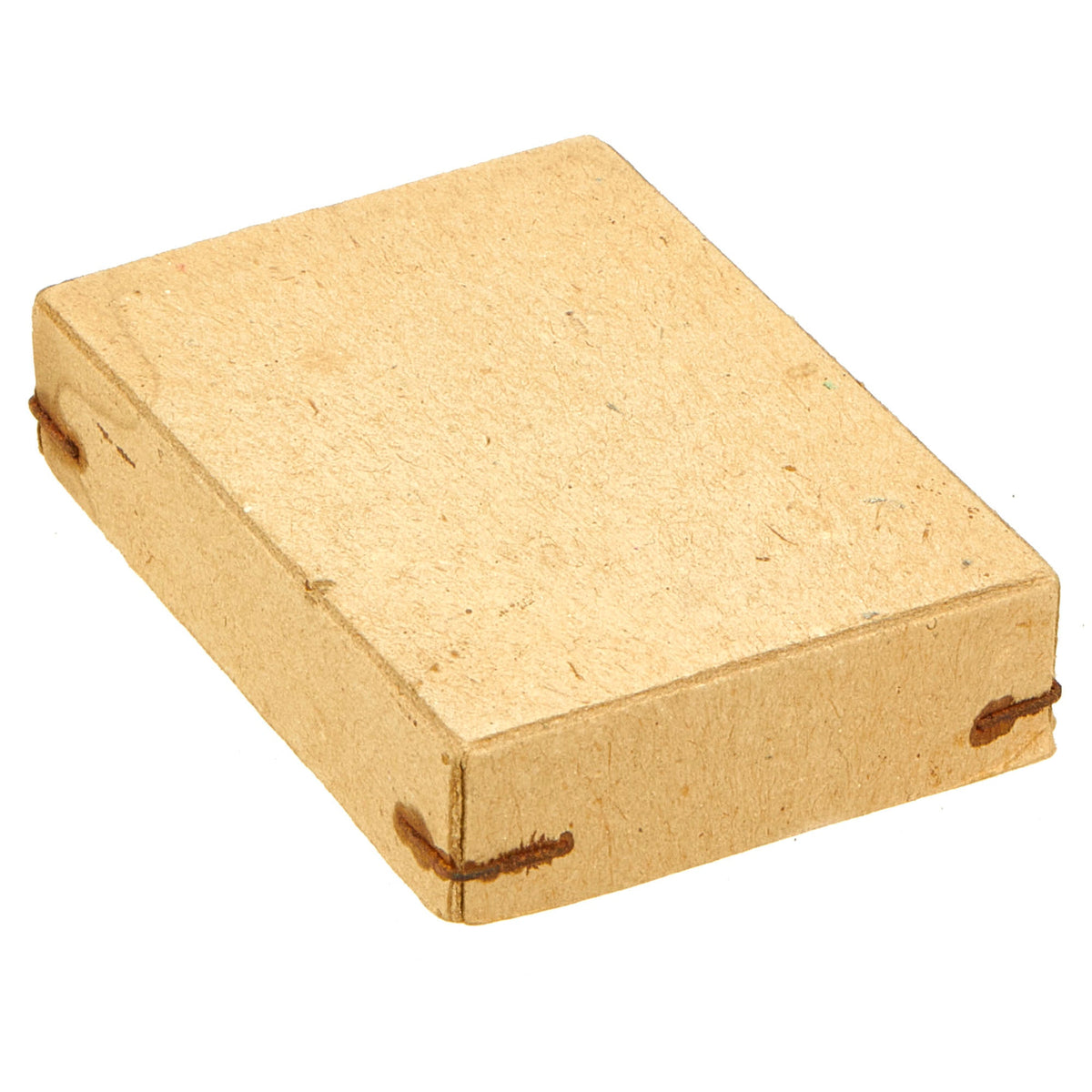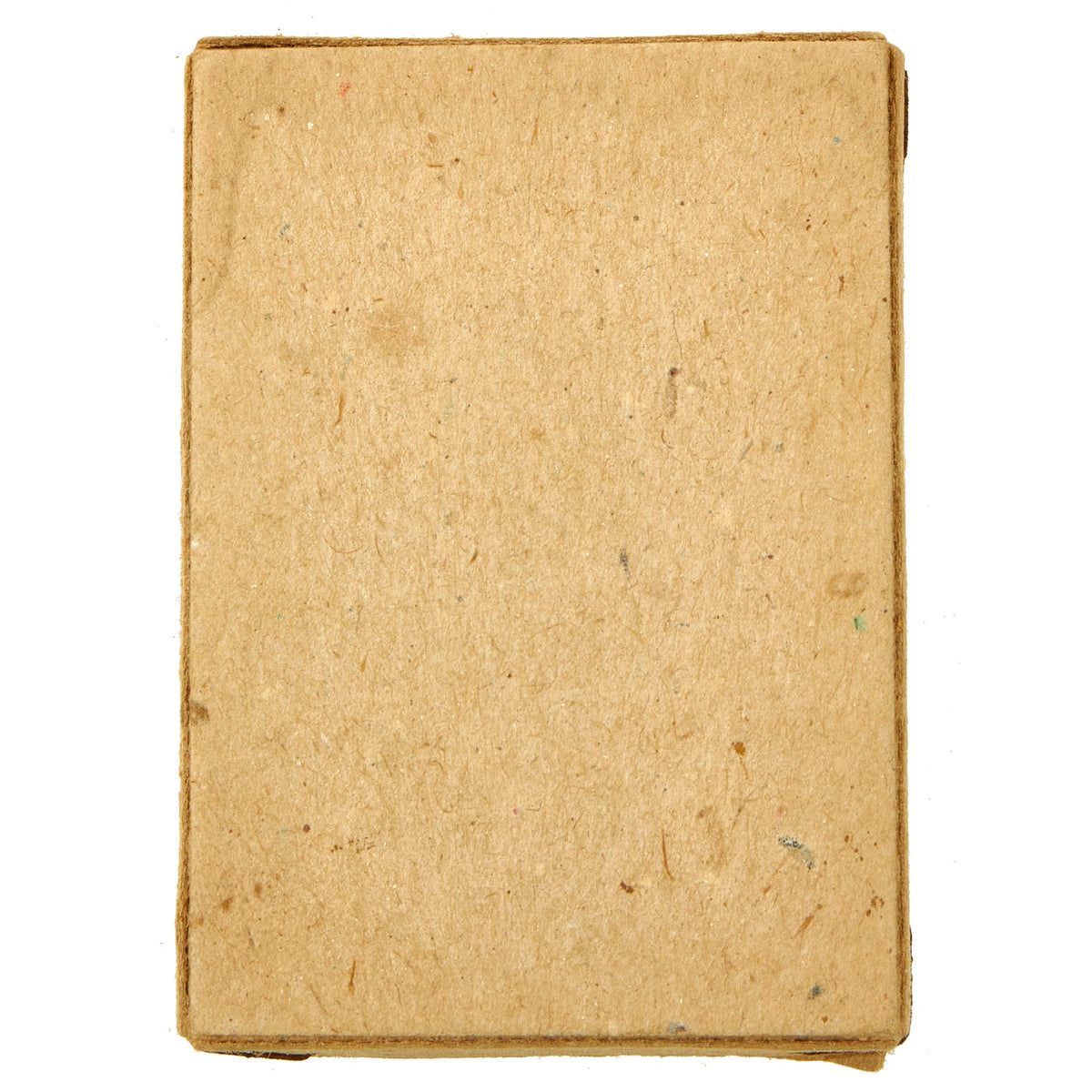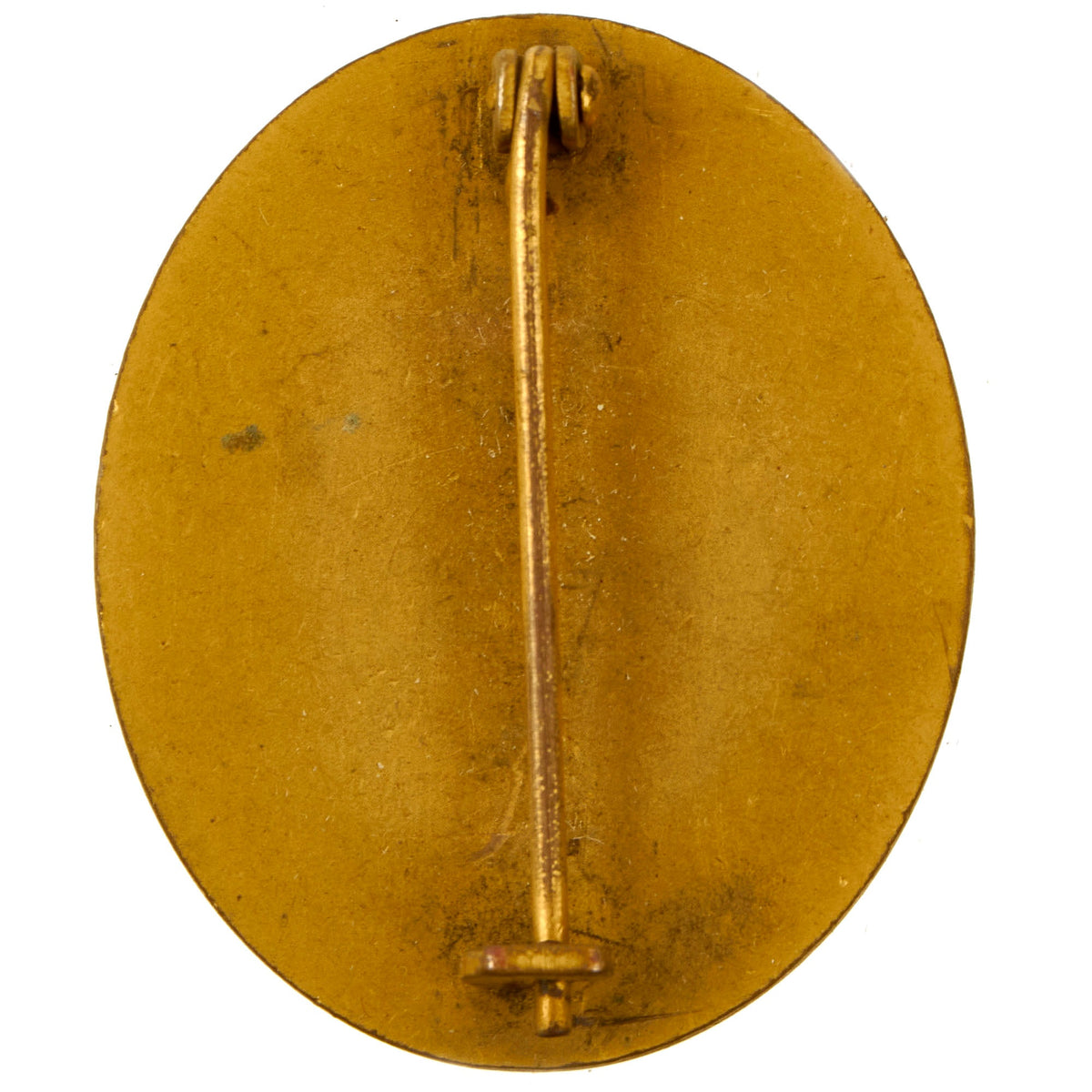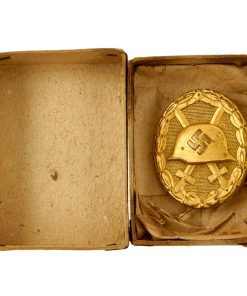Original German WWII Gold 1st Class Wound Badge in Original Box – Unmarked Brass Solid Back Original Items
$ 550,00 $ 165,00
Original Item: Only One Available. This is a great example of a German WWII 1st class Gold wound badge (Verwundetenabzeichen in Gelb), with “solid back” brass alloy construction. Gold / 1st class badges, which could be awarded posthumously, were awarded to those wounded five or more times. The oval badge depicts an embossed profile of a mobile swas (hook cross), above an M35 pattern helmet, which is above two crossed broad swords. This then lies on a pebbled field and is surrounded by a laurel leaf and berry wreath which is tied together at the bottom with a bow tie.
The reverse features a solid back, which is not maker marked, which was not uncommon. Specific characteristics of the design could possibly be used to identify the maker. It comes in it’s original issue cardboard box, with the original wrapping intact. Almost all of the original gold wash has been retained on the front, except on the raised areas, while the back has it retained at nearly 100% The pin catch is straight and undamaged. Really fantastic example!
This is an excellent example of the 1st Class German Wound Badge of WWII, complete with the original box.. Comes more than ready to be displayed!
The Wound Badge (Verwundetenabzeichen) was a German military decoration first promulgated by Wilhelm II, German Emperor on 3 March 1918, which was first awarded to soldiers of the German Army who were wounded during World War I. Between the world wars, it was awarded to members of the German armed forces who fought on the Nationalist side of the Spanish Civil War, 1938–39, and received combat related wounds. It was awarded to members in the Reichswehr, the Wehrmacht, SS and the auxiliary service organizations during World War II. After March 1943, due to the increasing number of Allied bombings, it was also awarded to civilians wounded in air raids. It was awarded when the wound was the result of enemy hostile action.
Badges were made of pressed steel, brass and zinc. All versions of the Wound Badge were worn on the lower left breast of the uniform or tunic. The badge was worn below all other awards on the left. It ranked lower than combat badges. There were 24 approved manufacturers of the Wound Badge. At first, the Wound Badge in Black was stamped from sheet brass, painted semi-matte black with a hollow reverse pin back attachment or of solid construction. From 1942, steel was used to make the badges. The Wound Badge in silver was made (before 1942) from silver-plated brass, and (after 1942) from lacquered zinc, and had a solid reverse with either a needle pin or a broad flat pin bar. The Wound Badge in Gold was a gilded version of the Wound Badge in Silver. In 1957, a revised version of the Wound Badge was authorized for wear; however, the previous type could still be worn if the swas were removed (for example by grinding).
This is an excellent, service worn example of the 1st Class German Wound Badge of WWII. Comes more than ready to be displayed!
Wound Badge of 20 July 1944
The 20 July 1944 Wound Badge was only issued to those injured during the failed attempt on Adolf H’s life at the Wolf’s Lair headquarters in Rastenburg, East Prussia. Twenty-four men were present when the bomb detonated; one officer was killed and three succumbed to their wounds a short time later. Thereafter, AH ordered a special wound badge be awarded commemorating the event, as he believed “fate had intervened” for him.
The 20 July Wound Badge is based on the common Wound Badge, but the helmet is slightly higher and larger; it also bears the date “20 Juli 1944” and a facsimile of H’s signature below the helmet and date. The 20 July Wound Badges were also awarded at three grades; black, silver, and gold. Recipients who held regulation Wound Badges were awarded the 20 July Wound Badge in a higher grade. All of these wound badges were made out of solid hallmarked silver by the C. E. Juncker firm.
Unlike the Wound Badge in Black, the 20 July Wound Badge in Black was not all black. Only the helmet and wreath were black; the background was in silver so that the date and facsimile signature could be seen. The 20 July Wound Badge in silver has black highlights on the helmet swas, the date, and the facsimile signature. The 20 July Wound Badge in gold had a silver background with the helmet and wreath colored gold. Unlike the standard Wound Badges, these were of two-piece construction.
AH presented the survivors with the special wound badge as well as a unique award document. The first were awarded in a ceremony on 20 August 1944. The four posthumous awards were sent to the recipients’ wives. Although AH had been injured in the bombing, he did not give one of these badges to himself. AH had earned his own Wound Badge (in black) in World War I on 18 May 1918.
The badge replaced the basic 1939 Wound Badge on those persons who were presented the 20 July Badge. It is important to note that this badge was more a personal gift from AH to those involved, and was intended to be a one-off souvenir of the event. Recipients of the 20 July wound badge could have their 20 July wound badges upgraded if they earned higher grades of the Wound Badge. Konteradmiral Hans-Erich Voss eventually had the 20 July Wound Badge in all three grades, earning it in black on 20 July 1944, and having it upgraded twice for subsequent wounds.
Fast Shipping with Professional Packaging
Thanks to our longstanding association with UPS FedEx DHL, and other major international carriers, we are able to provide a range of shipping options. Our warehouse staff is expertly trained and will wrap your products according to our exact and precise specifications. Prior to shipping, your goods will be thoroughly examined and securely secured. We ship to thousands clients each day across multiple countries. This shows how we're dedicated to be the largest retailer on the internet. Warehouses and distribution centres can be located throughout Europe as well as the USA.
Note: Orders with more than one item will be assigned a processing date depending on the item.
Before shipping before shipping, we'll conduct a thorough inspection of the items you have ordered. Today, the majority of orders will be delivered within 48 hours. The delivery time will be between 3-7 days.
Returns
The stock is dynamic and we cannot completely manage it because multiple stakeholders are involved, including our factory and warehouse. So the actual stock may alter at any time. It's possible that you may not receive your order once the order has been made.
Our policy is valid for a period of 30 days. If you don't receive the product within 30 days, we are not able to issue a refund or an exchange.
You can only return an item if it is unused and in the same state as the day you received it. You must have the item in its original packaging.
Related products
Uncategorized
Uncategorized
Uncategorized
Band of Brothers ORIGINAL GERMAN WWII Le. F.H. 18 10.5cm ARTILLERY PIECE Original Items
Uncategorized
Armored Burgonet Helmet & Polearm from Scottish Castle Leith Hall Circa 1700 Original Items
Uncategorized
Uncategorized
Uncategorized
Uncategorized
Uncategorized
Armoured Fighting Vehicles of the World: AFVs of World War One (Hardcover Book) New Made Items
Uncategorized
Uncategorized
Uncategorized
Uncategorized
Uncategorized
Uncategorized
Uncategorized
Uncategorized
Uncategorized

